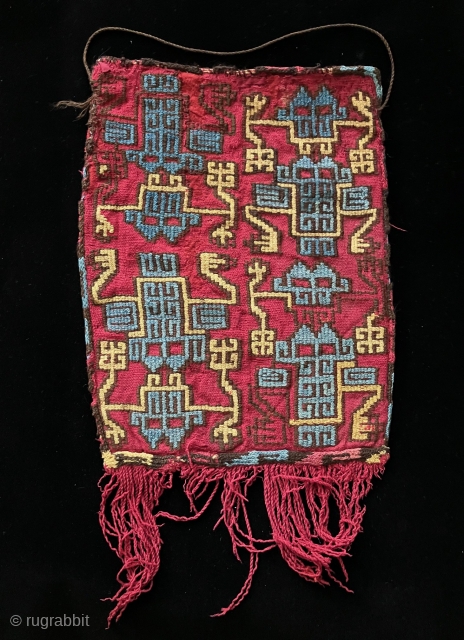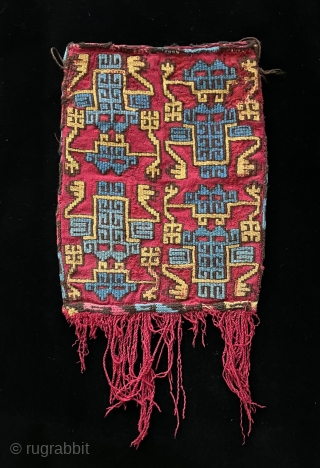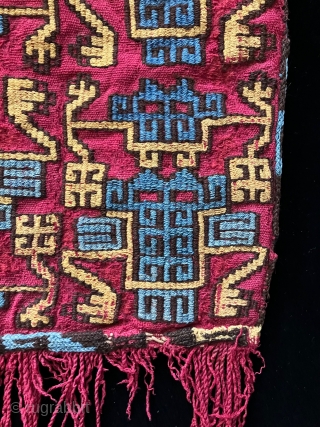Back
Water Strider Bag. This exceedingly rare, large, Nasca bag is in the so-called “Nasca Proliferous Style”. a.d. 300 - a.d. 600. Rio Grande Valley, Peru. Highly stylized zoomorphic forms are typical of this type of textile from the Nasca region. Four figures on each face of the bag alternate in direction left and right. The figures on this bag always reminds me of Water Striders, those insects that are able to walk on top of water due to a combination of high surface tension and long hydrophobic legs that help them to stay on top of the water’s surface. They more likely represent human or animal figures that are deliberately stylized as to be ambiguous. Spiders are also referenced in some textiles of this proliferous style. The bag is complete and in good condition. The structure is a balanced plain weave with supplmentary weft wrapping. Any damage was professionally conserved to a cloth liner. The bag is stable and supple. The intense red insect dyed color of this textile is very well preserved as are the blue and yellow dyes. The ground weave and patterning yarns are three ply alpaca yarns. Pieces in this style do not appear often in the market these days. Most have been collected years ago and reside in mainly in museum collections. Ex Neri collection, Ex Private collection London. Size: 9.5 x 16 inches.
price:
Inquire at jameswblackmon@gmail.com
- Home
- Antique Rugs by Region
- Category
- Profiles
- Post Items Free
- Albums
- Benaki Museum of Islamic Art
- Budapest: Ottoman Carpets
- Gulbenkian Museum
- Islamic Carpets. Brooklyn
- Islamic Textiles. Brooklyn
- Konya Museum: Rugs
- MKG, Hamburg
- MMA: Caucasian Carpets
- MMA: Mamluk Carpets
- MMA: Mughal Indian Carpets
- MMA: Ottoman Carpets
- MMA: Safavid Persian Carpets
- MMA: Turkmen Rugs
- McCoy Jones Kilims
- Ottoman textiles. Met
- Philadelphia Museum
- Rugs and Carpets: Berlin
- Seljuqs at the Met
- TIEM, Istanbul: Carpets
- V&A: Classical Carpets
- Vakiflar Carpets: Istanbul
- Baluch Rugs: Indianapolis
- Gallery Exhibitions
- Jaf an Exhibition
- Alberto Levi Gallery
- Andean Textile
- Christie's London: 2016
- Francesca Galloway
- HALI at 40
- ICOC Washington, DC 2018
- Jajims of the Shahsavan
- London Islamic Week April, 2018
- Mongolian Felts
- Navajo Rugs: JB Moore
- Persian Piled Weavings
- SF Tribal & Textile Art Show 2020
- SF Tribal 2019
- Sotheby's: C. Alexander
- Turkish Prayer Rugs
- Turkmen Main Carpets ICOC 2007











